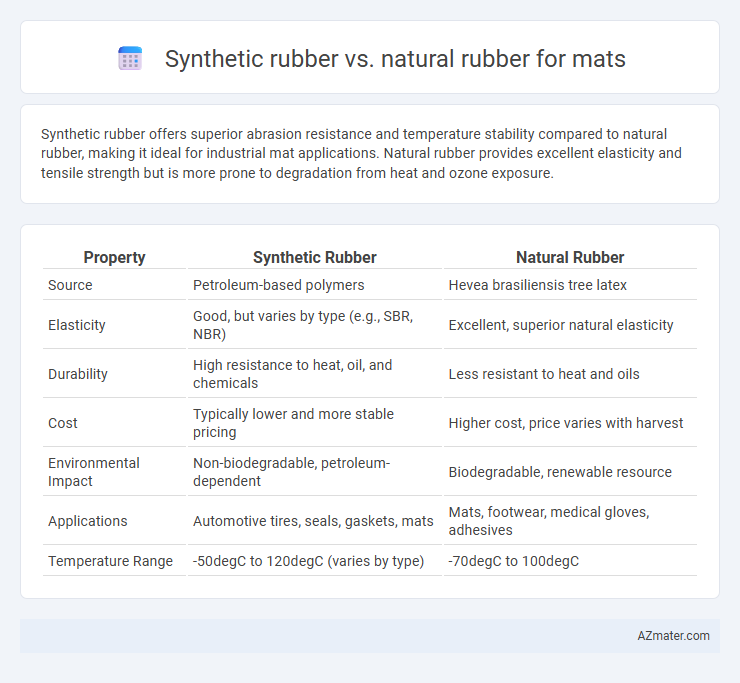Synthetic rubber offers superior abrasion resistance and temperature stability compared to natural rubber, making it ideal for industrial mat applications. Natural rubber provides excellent elasticity and tensile strength but is more prone to degradation from heat and ozone exposure.
Table of Comparison
| Property | Synthetic Rubber | Natural Rubber |
|---|---|---|
| Source | Petroleum-based polymers | Hevea brasiliensis tree latex |
| Elasticity | Good, but varies by type (e.g., SBR, NBR) | Excellent, superior natural elasticity |
| Durability | High resistance to heat, oil, and chemicals | Less resistant to heat and oils |
| Cost | Typically lower and more stable pricing | Higher cost, price varies with harvest |
| Environmental Impact | Non-biodegradable, petroleum-dependent | Biodegradable, renewable resource |
| Applications | Automotive tires, seals, gaskets, mats | Mats, footwear, medical gloves, adhesives |
| Temperature Range | -50degC to 120degC (varies by type) | -70degC to 100degC |
Introduction to Rubber Materials for Mats
Synthetic rubber offers superior resistance to heat, chemicals, and abrasion, making it ideal for mats in industrial and high-traffic environments. Natural rubber, derived from latex sap of the Hevea brasiliensis tree, is prized for its excellent elasticity, resilience, and biodegradability, commonly used in mats requiring comfort and eco-friendliness. Both materials provide unique properties suited to different mat applications, influencing durability, cost, and environmental impact.
What is Natural Rubber?
Natural rubber, derived from the latex sap of the Hevea brasiliensis tree, offers excellent elasticity, resilience, and tensile strength, making it a preferred material for mats requiring durability and flexibility. Its biodegradable properties contribute to environmental sustainability, distinguishing it from synthetic rubber, which is petroleum-based and less eco-friendly. The natural composition of rubber enhances grip and abrasion resistance, crucial for applications like floor mats and exercise mats where safety and comfort are priorities.
What is Synthetic Rubber?
Synthetic rubber is a man-made elastomer produced through the polymerization of petroleum-derived monomers such as styrene and butadiene, offering consistent quality and enhanced resistance to heat, abrasion, and chemicals compared to natural rubber. Common types used in mats include SBR (styrene-butadiene rubber) and NBR (nitrile rubber), which provide superior durability and flexibility for various flooring applications. Unlike natural rubber, synthetic rubber's properties can be tailored through chemical composition and processing methods, making it ideal for mats requiring specific performance characteristics like oil resistance and weather durability.
Key Properties Comparison
Synthetic rubber offers superior resistance to oil, heat, and abrasion, making it ideal for mats used in industrial and automotive environments, whereas natural rubber provides excellent elasticity and better grip due to its high tensile strength and resilience. Natural rubber mats typically exhibit greater biodegradability and flexibility, while synthetic rubber mats excel in chemical resistance and durability under extreme temperature variations. The choice between synthetic and natural rubber for mats depends on application-specific needs such as exposure to harsh chemicals, mechanical stress, and environmental sustainability.
Durability and Longevity
Synthetic rubber exhibits superior durability and longevity compared to natural rubber due to its enhanced resistance to abrasion, temperature extremes, and chemicals. Natural rubber mats tend to degrade faster under UV exposure and ozone, leading to cracking and loss of elasticity over time. Industrial applications favor synthetic rubber for mats where prolonged wear and environmental resilience are critical factors.
Environmental Impact and Sustainability
Synthetic rubber production relies heavily on petrochemicals, resulting in higher carbon emissions and less biodegradability compared to natural rubber, which is derived from renewable rubber tree latex and offers greater environmental sustainability. Natural rubber mats biodegrade more efficiently, reducing landfill waste and supporting circular economy principles, whereas synthetic rubber mats can persist in ecosystems, contributing to microplastic pollution. Sustainable sourcing of natural rubber, combined with certification programs like FSC or Rainforest Alliance, ensures responsible harvesting that protects biodiversity and supports local communities.
Performance in Various Conditions
Synthetic rubber offers superior resistance to heat, oil, and chemicals, making it ideal for mats exposed to harsh environments and heavy industrial use. Natural rubber excels in elasticity and provides excellent cushioning, performing well in moderate temperatures and offering natural slip resistance. In extreme cold or prolonged UV exposure, synthetic rubber maintains durability better, ensuring longer mat lifespan under diverse conditions.
Cost Analysis: Synthetic vs Natural Rubber
Synthetic rubber generally incurs higher initial production costs due to complex chemical processes and reliance on petroleum-based raw materials, whereas natural rubber benefits from lower raw material costs derived from rubber trees. However, synthetic rubber offers greater durability and resistance to environmental factors, potentially reducing long-term replacement and maintenance expenses. Natural rubber mats may be more cost-effective upfront but often require more frequent replacement, impacting overall lifecycle costs compared to synthetic alternatives.
Health and Safety Considerations
Synthetic rubber mats offer enhanced resistance to chemicals, oils, and UV exposure, making them less prone to degradation and safer in industrial environments where hazardous substances are present. Natural rubber mats provide excellent elasticity and cushioning but may trigger allergic reactions in sensitive individuals due to latex proteins. Both materials require proper handling and maintenance to prevent microbial growth and ensure slip resistance, addressing critical health and safety concerns in workplaces.
Which Rubber Type is Best for Your Mat?
Synthetic rubber offers superior durability, resistance to chemicals, and consistent performance in various environmental conditions, making it ideal for mats used in industrial or high-traffic areas. Natural rubber provides excellent elasticity, eco-friendliness, and a softer feel, which suits mats designed for comfort and indoor use. The best rubber type for your mat depends on specific needs such as durability, sustainability, and application environment.

Infographic: Synthetic rubber vs Natural rubber for Mat
 azmater.com
azmater.com